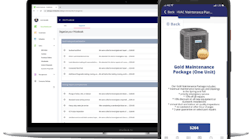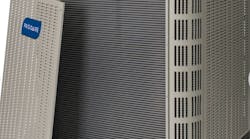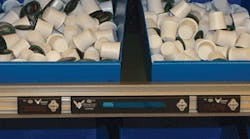Wholesale suppliers servicing their customers' small parts order demands in almost any industry know that orders requiring less than a case quantity grow with each passing year. Servicing the ‘just in time’ and replacement part needs of their customer base drives significant cost into a wholesaler's bottom line. Order fulfillment, which decades ago was the domain of manufacturers with lead times measured in weeks or months rather than days or hours, is one of the key facets of a good distributor's offerings to its customers. Over that same time span, the average order quantities dropped as well — from pallets to cases to individual units. Customers order more frequently and in smaller quantities, effectively pushing inventory back upstream within the overall supply chain and putting much of the burden for inventory holding capacity and rapid small order fulfillment onto distributors. For most distributors in today's environment, it is safe to say the slower and more costly their order fulfillment process is, the faster that customers will seek alternate sources of supply.
Order fulfillment picking at an individual piece level accounts for an average of 60 percent of all labor within a distribution center's operation. It is the most expensive part of the order fulfillment process, surpassing receiving, storage and nonspecialized packing combined. Given the large amount of a fulfillment center's labor effort and budget devoted to picking, time spent optimizing the productivity and throughput capacity in this area probably will yield the greatest return for the effort and capital invested. While there are many methods, technologies and equipment offerings that a distributor can pursue to keep their small parts order fulfillment costs down, picking productivity up, and accuracy levels at an acceptable level, some of the most prevalent and proven technologies in the marketplace are pick-to-light systems.
A pick-to-light system is a system of LED (or LCD) lights, buttons and display modules that are installed on each item's pick location. Pick-to-light systems are an alternative to manually picking items with a pick list or labels, and therefore some refer to it as “paperless picking.” The design of the pick system allows it to electronically assist the pickers in any picking operation by indicating the required pick location for each line item on a customer order and the quantity they need to pick. Though most often used to assist in picking less-than-case volumes and frequently applied in conjunction with case-flow rack, shelved racking or bin shelf pick locations, pick-to-light systems are not limited solely to those applications and storage mediums. You can apply this approach to almost any pick face types, including standard pallet positions (usually at the floor level in a conventional storage system).
For illustration, let's consider a discrete order picking environment for loose pieces that a picker puts in a shipping carton. In a conventional paper pick system, the picker references the pick list, travels to the first pick location indicated on the pick list, picks the appropriate product in the correct quantity, places the product into the shipping carton, marks that order line off the pick list in some fashion, references the pick list for the next order line, and moves the process steps again until the order or that shipping carton for the order is complete.
In a pick-to-light system, the operator indicates to the system (through a terminal or radio frequency scan gun) they are ready to pick an order, and every pick face with a pick in it for that order ‘lights up’ as the pick-to-light pick indicator lights up. The pick indicator light is usually a green or red beacon that illuminates in solid or flashing fashion. The operator moves to the first “lit” position. The pick-to-light module will have an LED or LCD indicator showing the number of units the worker must pick. The employee picks the correct number of units and presses the acknowledgement button on pick-to-light module. This extinguishes the pick indicator light (and the LED/LCD pick quantity indicator). The picker then moves to the next “lit” position and continues the process.
The productivity advantages of the pick-to-light system over a manual or paper pick system have been proven again and again over time. You can obtain these advantages in a discrete order pick environment, pick and pass environments and even batch picking operations. On average, pick-to-light applications can result in productivity improvements of 25 percent or more. They also offer an accuracy increase over paper picking that varies with the number of lines per order and the number of pieces per line. Many operations that formerly performed post pick audits on less-than-case orders to ensure order accuracy for their customers found that, with a pick-to-light system, pick accuracy increases are so significant as to allow for the elimination of post pick audits.
Page 2 of 2
Another advantage of the pick-to-light system is the ability to adjust picked order quantities as the employee picks the order. If, when a picker reaches a ‘lit’ pick position, there are not enough units in the pick face to satisfy the order demand indicated on the LED/LCD quantity indicator, the picker has the ability to decrement the quantity to the actual quantity picked. The pick-to-light control system communicates the reduced quantity to the host system, and an operation can determine the appropriate corrective course of action depending upon their order fulfillment policies.
Communication of the short pick information can allow the reduction of the order (and the customer billed accordingly); or drive an exception replenishment to bring the order up to the appropriate customer-ordered quantity; or put the order on hold until the needed items are back in stock. All these options are at the discretion of the operator's order fulfillment policies but do not require additional effort on the part of the picker to note a shortage on a pick list or a post order audit to drive any of the above resolution approaches.
Pick-to-light systems also offer a much shortened learning curve. They are much more “picker friendly” and allow for improved utilization of temporary operators, and greater productivity sooner from full-time regular operators. This can be a major benefit for an operation that requires temporary labor to meet seasonal demand requirements.
While the pick-to-light productivity advantages are clear, large SKU counts can drive large costs into a pick-to-light system. The more SKU pick faces requiring lights, the greater the cost of the pick-to-light system. Light modules can cost between $150 and $250 per SKU face, depending upon the quantity of pick-to-light modules purchased. There are several ways to reduce the cost of the system. The most common way is to utilize a bay display module to light multiple pick faces with one display, particularly for slower moving items. The bay display includes a text display to indicate the pick face within the pallet shelf bay, case flow bay or bin shelf bay from which the order requires an item. This reduces the number of displays required by as much as 80 percent.
No matter what pick-to-light approach a business utilizes, an evaluation of the order profiles generated by your operation's customer demands, and the productivity gains afforded by the pick-to-light technology, will allow for the configuration of a pick-to-light system with an appropriate return on investment. The reduced operating costs, coupled with the accuracy and learning curve advantages of a properly applied pick-to-light system, can provide an overall competitive advantage for any business with significant small part and less-then-case picking demands.
Bryan Jensen has 25 years of experience in retail and wholesale distribution, transportation and logistics, and is a vice president and principal with St. Onge Co. in York, PA, helping clients increase their picking productivity and accuracy among other logistics engineering needs. St. Onge Co. is a material handling and manufacturing consulting firm specializing in the planning, engineering and implementation of advanced material handling, information and control systems supporting logistics, manufacturing and distribution since 1983 (www.stonge.com). Contact Bryan at 717/840-8181 or at [email protected].







